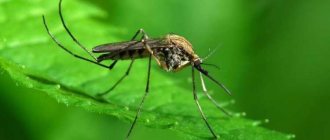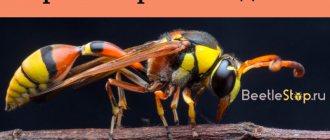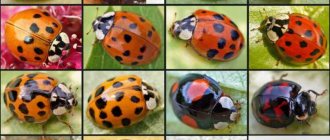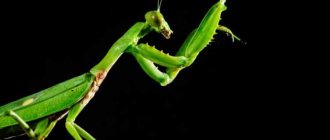- How long do mosquitoes live?
And why didn’t Noah kill those two mosquitoes then?
If the hero of our last article from the “zoology” section is
The ladybug is a very positive insect, then certainly little positive can be said about the hero of today’s article - the mosquito. But you can say a lot of interesting things, for example, the mosquito is a very ancient representative of the fauna of our planet, these small flying bloodsuckers bothered dinosaurs, and even in our time they are no less annoying.
Description, structure, characteristics
The mosquito belongs to the order Diptera and the family of blood-sucking mosquitoes. Mosquitoes have lived on Earth for as much as 145 million years.
The mosquito has a thin body from 4 to 14 mm in length. The wings of a mosquito are transparent, they reach up to 3 cm in diameter and are covered with small scales. The mosquito's abdomen consists of ten segments. The mosquito's long legs end in two claws.
The color of a mosquito, in addition to the usual black or brown, can also be very unusual; green, yellow, orange and red mosquitoes are found in nature.
Interesting fact: among the large family of mosquitoes, there are also wingless species.
Mosquitoes also have a kind of antenna, consisting of 15 parts, on which the olfactory organs and auditory receptors are located, working on the principle of a temperature sensor. It is with the help of such an antenna that the mosquito finds its victim.
Nutrition
Culex pipiens eats food of animal and plant origin. An important source of nutrients from the point of view of procreation is the blood of vertebrates. Culexes most often bite humans and birds living near populated areas. In urban environments, bloodsuckers most often attack pigeons. At the end of the summer period, the insect switches to nectar to accumulate carbohydrates and form fat necessary for wintering.
Interested to know who gets bitten by mosquitoes more often? Then follow the link!
Mosquitoes find different food sources in residential areas and natural environments. Sugar-rich foods are the most valuable resource used by the Culex as a source of energy. Olfactory and visual sensitivity helps to find nectar and other types of plant foods. Females search for sources of blood using a complex of behavioral reactions and external sensitivity. The body of an adult is equipped with 1300 sense organs.
The parasite's hunt consists of many stages. To detect a living organism suitable for feeding, the common mosquito uses visual and chemical signals coming from the environment. The smell emitted by sweat and other biological fluids attracts the bloodsucker. Many people are interested in how many days a common mosquito lives after being bitten. According to the observations of entomologists, females maintain vital activity for up to 3 weeks after feeding in order to lay the maximum number of eggs.
Habitats
Almost everywhere, except always cold
Antarctica, but these insects are most common in areas with a hot and humid climate, where they remain active throughout the year. In temperate latitudes, during the winter cold, they hibernate, awakening with the arrival of spring. It is interesting that even in the Arctic, during those few weeks when it gets warm, mosquitoes breed with terrible force and are very annoying to the herds of deer there.
Cycle of life
The lifespan of a mosquito directly depends on the habitat into which it finds itself after birth. Temperature plays the main role. At +25°C, insects live for about 45 days; at +20°C, the lifespan of a mosquito increases to 60 days. A decrease in temperature below +15°C slows down metabolic processes in the body of adults and larvae, prolonging their existence to 119 days.
On a note!
How long a common mosquito lives depends on its gender. The average life expectancy of a male is 14 days. Genetic ability – 20 days. When talking about timing, they most often mean how long the female lives.
Mosquito reproduction
In the wild, mosquitoes drink the blood of animals and reproduce healthy offspring in large quantities. In a humid, moderately warm environment, the mosquito can live for almost 2 months. An increase in indicators from +25 degrees Celsius does not allow insects to rise into the air, as they instantly lose moisture. Whereas, under favorable conditions, mosquitoes reach the 9th floor. A decrease from +10 degrees Celsius helps to slow down metabolic processes, the insect falls into suspended animation, but continues to live.
Enemies in nature
Of course, mosquitoes themselves have many enemies in natural conditions, and they and their larvae are a tasty treat for many insects, birds, fish and amphibians:
frogs, newts, salamanders, dragonflies, spiders, bats, water mites, lizards.
It is also very interesting that the larvae of mosquitoes often feed on the larvae of insects such as the swimming beetle and dragonfly.
Types, photos and names
There are a great many different types of mosquitoes in nature; we will describe the most interesting of them:
Common mosquito (squeaker)
It is the most common representative of the mosquito family. It lives over a wide geographic range; it is these mosquitoes that often bother us during forest picnics, walks near water bodies, or even just at home.
Centipede mosquito (caramora)
These mosquitoes live exclusively in places with high humidity: near ponds, swamps, and in shady thickets. They are large in size for mosquitoes - reaching 4-8 cm in length. And these mosquitoes are also safe for humans, since they feed exclusively on nectar and plant juices, but they can cause harm to farmland and forest plantings.
Anopheles mosquito
This type of mosquito is perhaps the most dangerous among all, since it is a carrier of the most dangerous parasites - malarial plasmodium, which causes malaria. It is similar in size and appearance to a regular mosquito, the only thing that distinguishes it is its longer hind legs.
Chionei (winter mosquitoes)
These mosquitoes are similar to both large spiders and centipedes. However, they differ from both of them in their way of life. They differ from other mosquitoes in their ability to tolerate cold and therefore winter mosquitoes can be found even in winter.
Mosquito Dergun
Also known as the bell mosquito. It is a harmless representative of the mosquito family, as it feeds exclusively on plant foods. It lives mainly along the banks of water bodies. It differs from other mosquitoes in its appearance - it has a yellowish-green color with long limbs.
Features of food for females
Females require blood - this can be explained by the need for animal protein contained in the lymph, without which it is not possible to form eggs after the mating procedure. Due to this reason, humans and mammals suffer from bites and attacks. There are species of mosquitoes that bite birds and reptiles.
When the skin is bitten, insect saliva is also injected into the microscopic hole, which contains anticoagulants - they prevent the blood from clotting and thickening, which is why the female can easily absorb liquid blood through her long proboscis. For hunting, females choose the evening and night time, when the scorching rays of the sun disappear.
Also, the saliva of bloodsuckers contains substances that cause allergies in humans. Therefore, the bite site is red, swollen, and severely itchy in the affected area. Antihistamines can be used to relieve unpleasant symptoms.
Reproduction
The life cycle of a mosquito consists of four stages of development:
First, the males fly out into the light, having gathered in a swarm, they wait for females to mate. After mating, the fertilized female goes in search of blood, which she needs to lay her eggs.
How to get rid of mosquitoes at home
Sometimes mosquitoes have a bad habit of entering houses, bothering people in every possible way. As a means of protection against mosquitoes, people have developed many means, among which special mosquito nets are very useful, preventing mosquitoes from entering the house through open windows.
Another effective remedy for mosquitoes can be special repellents, substances that emit odors that repel mosquitoes, although their disadvantage may be that the smells of repellents can have a bad effect not only on mosquitoes, but also on people.
A pot of geranium is quite suitable as a folk remedy for fighting mosquitoes, whose smell also repels these flying bloodsuckers.
Why do mosquitoes bite some people more than others?
You've most likely noticed that some people are bitten by mosquitoes much more often. This is really not a coincidence. When choosing a victim, insects are guided by specific chemicals that are released along with sweat. Mosquitoes are attracted by the following factors:
- Doing physical activity. Here, mosquitoes pay attention to the increase in the amount of lactic acid in the body, so they actively react to people engaged in physical exercise.
- Specific blood type. Most often, mosquitoes fly to blood group 1, since it has a special smell that attracts mosquitoes.
- Alcohol. If a person has been drinking, the presence of alcohol in the blood attracts the insect.
- Large amounts of carbon dioxide. When exhaling, some groups of people release much more carbon dioxide from their lungs, which mosquitoes notice. Most often these are pregnant women, tall people, and overweight people.
- Dark shades in clothes.
Interesting Facts
- It was the mosquito that played a key role in the good old science fiction film “Jurassic Park”; through the blood found in an ancient mosquito trapped in amber, scientists were able to access the DNA of dinosaurs and thus “resurrect” these prehistoric lizards.
- The flight speed of a mosquito is on average 3.2 km per hour, but skillfully using air currents, mosquitoes are able to fly up to 100 km.
- The mosquito's weight is so small that once it hits the web it will not cause vibrations and will not attract the spider's attention.
Video
And in conclusion, an interesting documentary about one dangerous species of mosquito - “killer mosquitoes”.
Author: Pavel Chaika, editor-in-chief of Poznavaika magazine
When writing the article, I tried to make it as interesting, useful and high-quality as possible. I would be grateful for any feedback and constructive criticism in the form of comments on the article. You can also write your wish/question/suggestion to my email [email protected] or Facebook, with respect, the author.
Author page
This article is available in English -
Mosquito.











